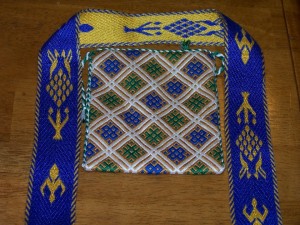First off, I’ve been finding interesting articles all week, and collecting them, so without further adieu, a few links:
- Edyth Miller’s “Pattern Darning Tutorial” – while pattern darning is often assumed to be more modern (i.e. 18th/19th century) it can be dated back to ther 12th century. Here Edyth Miller provides a clear tutorial for the technique.
- An article on the origins of most popular tablet weaving patterns. – This article is posted on deviantart, but includes lovely examples and good references.
- Alfrun Ketta’s ” Viking Textiles – A deeper look at plaids, stripes and checks “ – Alfrun Ketta addresses the question of whether Vikings (and viking reenactors) can wear plaids. The answer is yes … ish. She includes a few examples of plaids that would or would not be appropriate and explains her reasons why.
Secondly, I’ve been (unsuccessfully) trying to design knotwork in the Snartemo 4 colour technique, but in the process ended up digging out a lot of my old 3/1 broken twill notes. So here a very brief explanation of how I weave 3/1 broken twill.
In 3/1 broken twill, patterns will have a light and a dark colour. Each of the pattern tablets is threaded with two light and two dark colours, just as one does for doubleface. But then, using Collingwood’s 2 pack method, the cards are divided into two groups: the odd numbered cards form one group, and the even numbered cards form the other. Each group turns as a whole; colour changes are created by flipping a card around its vertical axis – which reverse the threading – rather than by changing turning direction.
Setting up the two groups:
- In each group flip the cards as needed so that they alternate S and Z threading.
- In the odd group, turn the cards so that the background colour goes through the two holes closes to the weaver. This is the “vertical” position, because the two holes threaded with the background colour are one above the other (aka vertical if the warp is held horizontal).
- In the even group, turn the cards so that the background colour goes through the two top holes. This is the “horizontal” position, because the two holes threaded with the background colour are beside each other (aka horizontal if the warp is held horizontal)
Turning Directions:
The cards are turned in a few turn repeat. Each of the two groups moves 2F/2B, but there is an offset because of the differing starting positions. Repeating this turning should yield a solid-coloured band with a structural diagonal.
| Turn | Odd Group | Even Group |
| 1 | Forward | Forward |
| 2 | Forward | Back |
| 3 | Back | Back |
| 4 | Back | Forward |
Patterns:
 I draw my patterns on a rectangular grid with a brick like pattern; Tree with Birds Pattern is a pattern that uses 32 cards, but because of the symmetry the setup is modified slightly so that the second set of 16 cards completely mirrors the setup of the first 16 cards
I draw my patterns on a rectangular grid with a brick like pattern; Tree with Birds Pattern is a pattern that uses 32 cards, but because of the symmetry the setup is modified slightly so that the second set of 16 cards completely mirrors the setup of the first 16 cards
In the pattern, each column represents one card over all the many turns; each rectangle represents that card for two turns. Note how the odd and even rectangles are offset, because of the offset turning directions. In the right side of the pattern you can see the changes needed for the colour changes; if the next rectangle switches from white to grey or vice versa, flip the card.
But that would give you some ugly edges, so sometimes we also need to flip the card when the colour is horizontal rather than vertical. Those flips are represented in the left half of the pattern by the blue < in a rectangle.